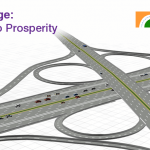
A new Greenfield super communication expressway namely the Maharashtra Samruddhi Mahamarg (MSM) is planned to link Nagpur and Mumbai. The MSM will be fully access controlled to help people travel from Nagpur to Mumbai in just 8 hours time, which is way lesser than the current journey time of 13 hours. The aim is to allow vehicles to travel safely at a constant decided speed per km per hour.
From Nagpur to Mumbai in 8 hours!
Since MSM passes through 10 districts, travelers would want to enter or exit in any of these 10 districts at the entry / exit points provided. Also the travelers would want to exit at the tourist/ industrial/ religious and commercial places in any of these districts or halt at rest areas, fuel stations. For this the MSM would have to be connected with other major or minor roads, which have to be made in a manner that it does not hamper the speed and safety of other vehicular traffic entering or exiting the MSM.
The MSM is a high capacity, high speed, multi-lane roadway with full access control in both urban and rural settings. Access controlled means exclusion of random movement of any kind to and from the MSM main line. So access and egress for vehicular traffic will occur at specific zones outside of the main line traffic, which are called as service interchanges where speed provision can be made to minimize speed differentials between entering and exiting vehicles and main line traffic. So the primary purpose of interchanges is to reduce conflicts caused by vehicle crossings. The interchanges will interconnect MSM with other highways and major and minor roads. These service interchanges would enable easy access of MSM to vehicles entering and exiting from villages and towns of the en-route districts.
MSM has over 20 service interchanges at crossings or nearest points of other expressways, national and state highways, and important arterial roads, at major roads to important ports, airports, and material transport facilities, commercial and industrial areas as well as places of religious and tourist interest. The entry and exit on MSM are only at interchanges through entry/ exit ramps. The interchanges were designed considering several factors such as site topography, traffic volume, geometric controls, land use, providing access to tourist places and rest areas, safety, etc. MORTH and IRC guidelines were also considered when designing. Accordingly diamond, trumpet, double trumpet and clover leaf types of interchanges are proposed.
The interchanges proposed in the 10 districts are as follows.
- Nagpur and Wardha – 6
- Amravati, Washim and Buldhana – 8
- Jalna and Aurangabad – 6
- Ahmednagar and Nashik – 4
- Thane – 6
Definition – An interchange is a road junction that typically uses grade separation, and one or more ramps, to permit traffic on at least one highway to pass through the junction without directly crossing any other traffic stream. It differs from a standard intersection, at which roads cross at grade. Interchanges are used when at least one of the roads is a controlled-access highway or a limited-access divided highway, though they may occasionally be used at junctions between two surface streets. In short, interchange is a system where traffic between two or more roadways flows at different levels in the grade separated junctions.


